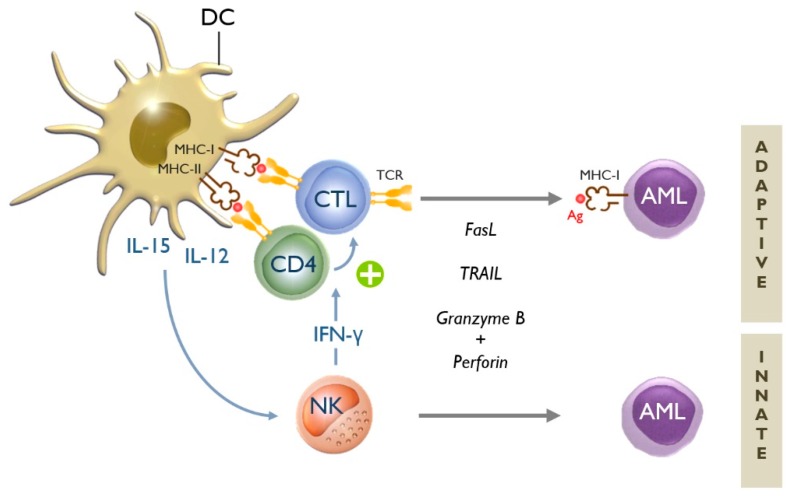Figure 1.
Dendritic cells are key to the induction of adaptive and innate anti-leukemia immunity. Dendritic cells (DCs) can stimulate both adaptive and innate immune responses against acute myeloid leukemia (AML) cells [12]. There exist two types of adaptive immune responses: humoral or B-cell-mediated (not shown in this figure), and cellular or T-cell-mediated immune responses. The initiation of the latter type of immune response involves the presentation of AML-related antigens (Ag) by DCs via major histocompatibility complex (MHC) class I and II molecules to CD8+ cytotoxic T-lymphocytes (CTLs) and CD4+ helper T cells, respectively. If appropriately stimulated, naive CD4+ T cells (TH0) can be polarized into T helper type 1 (TH1) cells, which in turn support the generation of antigen-specific CTLs (+). These CTLs—via their specific T-cell receptor (TCR)—are capable of recognizing AML cells that display the particular antigen(s) to which the CTLs are directed [12]. CTLs possess different tools in their armamentarium to kill AML cells, such as death receptor ligands (e.g., Fas ligand (FasL) and tumor necrosis factor-related apoptosis-inducing ligand (TRAIL)) and cytolytic proteins released from intracytoplasmic granules (e.g., granzyme B and perforin) [16]. The innate arm of the immune system is unequivocally important for mounting effective anti-leukemia immunity [20]. Innate effector cells, predominantly natural killer (NK) cells, are able to eradicate AML cells in a non-antigen-specific, non-MHC-restricted manner. NK cells can utilize the same cytolytic tools as CTLs [16]. In addition to their direct cytotoxic activity, NK cells also play an immunoregulatory role by secreting cytokines such as interferon (IFN)-γ. Through this so-called “helper” function, NK cells can support the generation of TH1 and CTL responses [21,22]. Several DC-derived cytokines are known to be involved in DC-mediated NK-cell activation, including interleukin (IL)-12 and IL-15 [23]. The latter is usually not secreted by the DCs, but “trans-presented” on the DC surface via IL-15 receptor-α [24,25].

